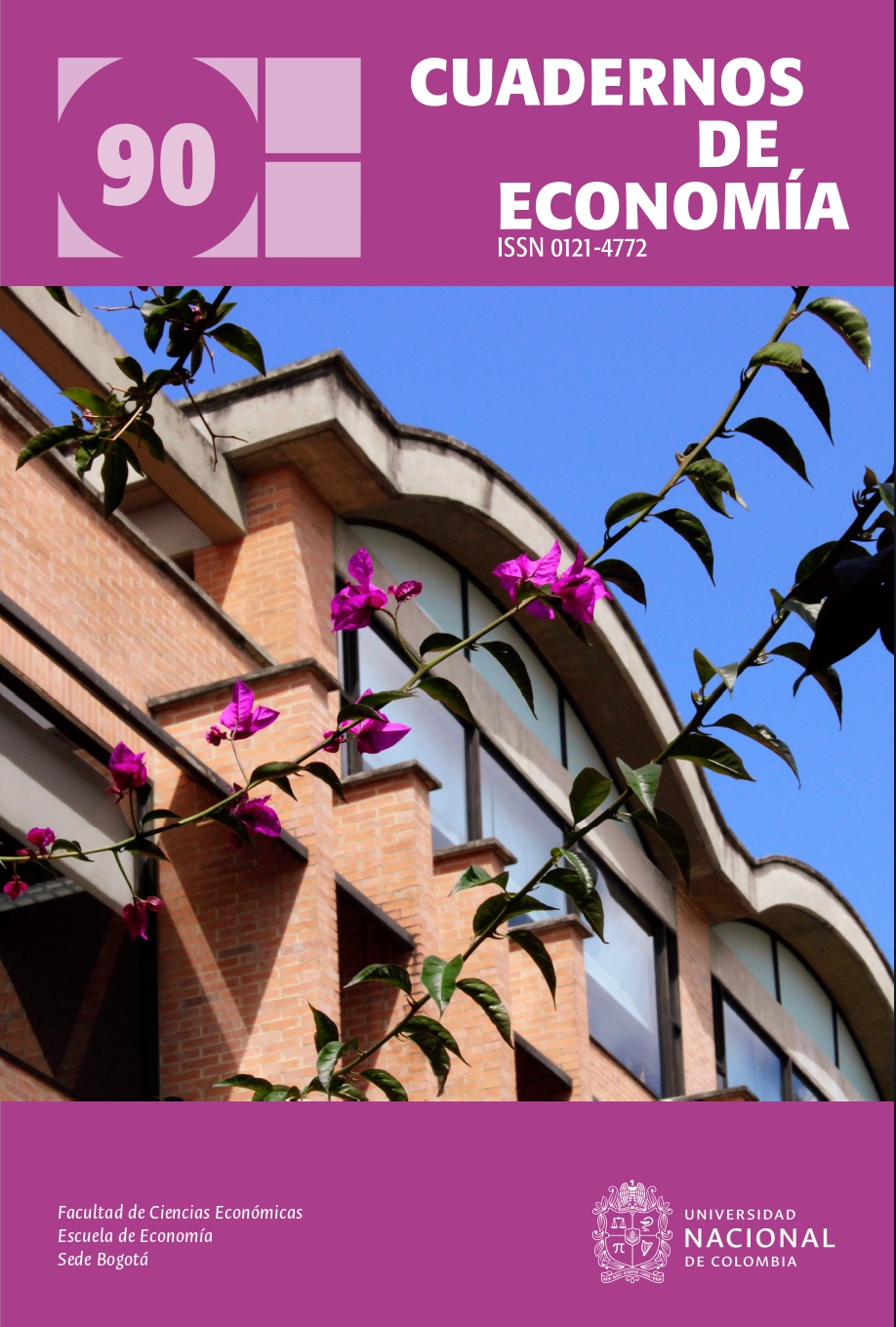Crecimiento multisectorial colombiano, 1975-2016
Colombian multisectoral growth, 1975-2016
DOI:
https://doi.org/10.15446/cuad.econ.v42n90.98429Palabras clave:
Crecimiento multisectorial, balanza comercial, Ley de Thirlwall, sectores económicos. (es)Multisectorial growth, trade balance, Thirlwall's Law, economic sectors. (en)
Descargas
Esta investigación aborda el crecimiento económico colombiano desde un enfoque de crecimiento multisectorial restringido por balanza de pagos, entre 1975-2016. Se concluye que la “ley de Thirlwall multisectorial” y la “ley de Thirlwall” son buenos predictores del crecimiento colombiano. Los sectores minero y agrícola aportan al crecimiento multisectorial del país, mientras la contribución del sector industrial es menor. Se muestra que en Colombia no ha habido un cambio estructural que impulse las exportaciones de los bienes con las mayores elasticidades ingreso y disminuya las importaciones con las más altas elasticidades ingreso, lo que ha limitado el crecimiento.
This research addresses with Colombian economic growth, from a multisectorial growth approach restricted by balance of payments, between 1975-2015. It is concluded that the "multisectorial Thirlwall's law" and the "Thirlwall's law" are good predictors of Colombian growth. The mining and agricultural sectors contribute to the multisectorial growth of the country, while the industrial sector does not. It is shown that in Colombia there has not been a structural change that boosts exports of goods with the highest income elasticities and decreases imports with the highest income elasticities, which has restricted growth.
Referencias
Araujo, R., & Lima, G. (2007). A structural economic dynamics approach to balance-of-payments-constrained growth. Cambridge Journal of Economics, 31(5), 755-774. https://doi.org/10.1093/cje/bem006
Banco de la República. (2019). https://www.banrep.gov.co/es
Cimoli, M., Porcile, G., & Rovira, S. (2009). Structural change and the BOP-constraint: why did Latin America fail to converge?. Cambridge Journal of Economics, 34(2), 389-411. https://doi.org/10.1093/cje/ben060
Comisión Económica para América Latina y el Caribe. (2007). Progreso técnico y cambio estructural en América Latina. Cepal.
Davidson, P. (1997). A post keynesian positive contribution to “theory”. Journal of Post Keynesian Economics, 13(2), 298-303. 10.1080/01603477.1990.11489849
Departamento Administrativo Nacional de Estadística. (2019). Encuesta anual manufacturera (EAM). https://www.dane.gov.co/index.php/estadisticas-por-tema/industria/encuesta-anual-manufacturera-enam
Departamento Nacional de Planeación. (2019). https://www.dnp.gov.co/
Elliot, D. R., & Rhodd, R. (1999). Explaining growth rate differences in highly indebted countries: an extension to Thirlwall and Hussain. Applied Economics, 31(9), 1145-1148. 10.1080/000368499323634
Ferreira, A., & Canuto, O. (2001). Thirlwall’s law and foreign capital service: the case of Brazil. Journal of Post Keynesian Economics, 32(1), 115-136. 10.2753/PKE0160-3477320108
García, M. M., & Quevedo, C. A. (2005). Crecimiento económico y balanza de pagos: evidencia empírica para Colombia. Cuadernos de Economía, 24(43).
Gouvea, R. R., & Lima, G. (2010). Structural change, balance of payments constraint and economic growth: evidence from the multisectoral Thirlwall’s law. Journal of Post Keynesian Economics, 33(1), 169-204. 10.2753/PKE0160-3477330109
Grossman, G. M., & Helpman, E. (1989). Comparative advantage and long-run growth. American Economic Review, 80(4), 796-815. 10.3386/w2809
Harrod, R. F. (1939). An essay in dynamic theory, wiley on behalf of the Royal Economic Society. Economic Journal, 49(193), 14-33.10.2307/2225181.
Keynes, J. M. (1978). The General Theory of Employment, Interest and Money. Cambridge University Press.
Lopez, J., & Cruz, A. (2000). Thirwall’s law and beyond: the Latin American Experience. Journal of Post Keynesian Economics, 22(3), 477-495. DOI: https://doi.org/10.1080/01603477.2000.11490253
Malthus, T. (1978). An Essay On The Principle Of Population. Penguin Classics.
Márquez, Y. (2006). Estimaciones econométricas del crecimiento en Colombia mediante la ley de Thirlwall. Cuadernos de Economía, XXV(44), 119-142.
McCombie, J. S. L., & Thirlwall, A. P. (1994). Economic Growth and the Balance of Payments Constraint. Palgrave Macmillan. DOI: https://doi.org/10.1007/978-1-349-23121-8
Moreno-Brid, J., & Pérez, E. (2000). Balance of payments constrained growth in Central America: 1950-96. Journal of Post Keynesian Economics, 22(1), 131-147. 10.1080/01603477.1999.11490231
Moreno-Brid, J. C. (2003). Capital Flows, Interest Payments and the Balance of Payments Constrained Growth Model: A theoretical and empirical analysis. Metroeconomica, 54(2), pp. 346-365. DOI: https://doi.org/10.1111/1467-999X.00170
Pasinetti, L. (1981). Structural Change and Economic Growth: a Theoretical Essay on the Dynamics of the Wealth of the Nations. Cambridge University Press.
Pasinetti, L. (1993). Structural Economic Dynamics. A Theory of the Economic Consequences of Human Learning. Cambridge University Press. DOI: https://doi.org/10.1017/CBO9780511551444
Prebisch, R. (1950). The Economic Development of Latin America and Its Principal Problems. United Nations Department of Economic Affairs, Economic Commission for Latin America.
Romero, J., & McCombie, J. (2015). The multi-sectoral Thirlwall’s law: evidence from 14 developed European countries using product level data. International Review of Applied Economics, 30(3), 301-325. 10.1080/02692171.2015.1102207
Sánchez, G. (2011). Conocimiento y crecimiento colombiano: una aproximación a través del progreso tecnológico y el cambio técnico. Revista de la Facultad de Ciencias Económicas: Investigación y Reflexión, 19(2). DOI: https://doi.org/10.18359/rfce.2251
Sánchez, G. (2013). El conocimiento en la economía global y colombiana. Revista de la Facultad de Ciencias Económicas: Investigación y Reflexión, XXI(2).
Sánchez-Ruiz, H., & Sánchez-Pérez, G. (2021). Productividad en Colombia: un desafío pendiente. Ensayos de Economía, 31(58), 36-67. https://doi.org/10.15446/ede.v31n58.88625
Thirlwall, A. P. (1979). The balance of payments constraints as an explanation of international growth rate differences. PSL Quarterly Review, 64(259), 429-438.
Thirlwall, A. P. (2011). Balance of payments constrained growth models: history and overview. En E. Soukiazis & P. A. Cerqueira (Eds.), Models of Balance of Payments Constrained Growth. Palgrave Macmillan. DOI: https://doi.org/10.1057/9781137023957_2
Velasco, R. (2006). ¿Hay restricción externa del crecimiento en Colombia de 1925 a 2000? Cuadernos de Economía, 25(44), 99-118.
Cómo citar
APA
ACM
ACS
ABNT
Chicago
Harvard
IEEE
MLA
Turabian
Vancouver
Descargar cita
Licencia
Derechos de autor 2023 Cuadernos de Economía

Esta obra está bajo una licencia internacional Creative Commons Atribución-NoComercial-SinDerivadas 4.0.
Cuadernos de Economía a través de la División de Bibliotecas de la Universidad Nacional de Colombia promueve y garantiza el acceso abierto de todos sus contenidos. Los artículos publicados por la revista se encuentran disponibles globalmente con acceso abierto y licenciados bajo los términos de Creative Commons Atribución-No_Comercial-Sin_Derivadas 4.0 Internacional (CC BY-NC-ND 4.0), lo que implica lo siguiente:




















